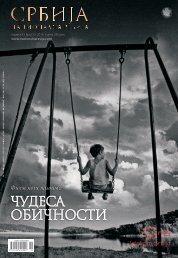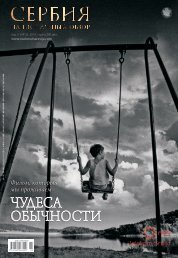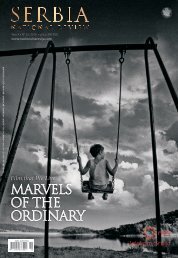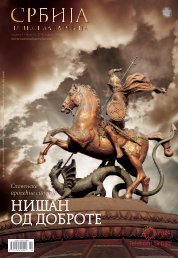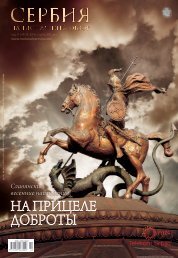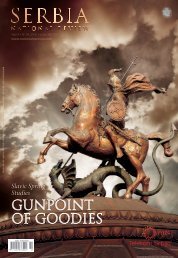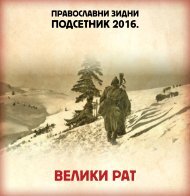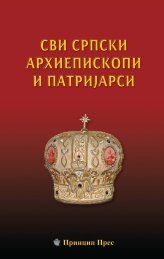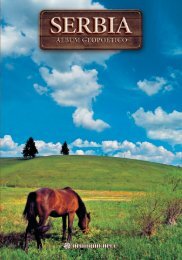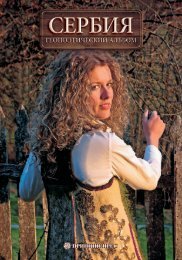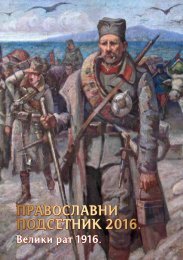Monografija - prvo izdanje - niska rezolucija
You also want an ePaper? Increase the reach of your titles
YUMPU automatically turns print PDFs into web optimized ePapers that Google loves.
278<br />
Је дан дру ги сли кар из га ле ри је ме ђу рат них на и ваца,<br />
до жи вео је „ори ги нал” суд би ну „про кле тог сли ка ра”, на<br />
сво јој ко жи осе тив ши ко ли ко про клет ство мо же, по го то ву у<br />
при ми тив ној сре ди ни, да бу де та ле нат и ства ра лач ки не мир.<br />
Си на си ро ма шног ко чи ја ша из Бач ке Па лан ке, Пе те ра На ђапа<br />
ти ја, под на дим ком „Ку кац” за пам ти ле су мно ге ло кал не<br />
ка фа не. Тра ћио је свој ве ли ки та ле нат, сли ка ју ћи се ља ке<br />
за ту ру пи ћа, лу тао рав ни цом оби ла зе ћи са ла ше где је портре<br />
те бо га тим па о ри ма ра дио за стан и хра ну, по ни жа ва ли<br />
су га да им сли ка оми ље ног во ла и нај дра жу сви њу. На шли<br />
су га, из ну ре ног ал ко хо лом, ис пру же ног на сла ми у шта ли<br />
ње го вог оца, мр твог.<br />
Јанко Брашић, „Портрет мајке”<br />
Janko Brašić, “Portrait of a mother”<br />
On the opposite pole from this tortured soul was a great<br />
and celebrated name, Emerik Feješ, who during his lifetime collected<br />
postcards of foreign cities in the way that others collect<br />
stamps (his inclination to small objects may be a result of his<br />
profession as a comb and button maker). He made paintings<br />
of the places he had never travelled to, using the postcards to<br />
inspire his interpretation. From sleepy Novi Sad, whose coatof-arms<br />
contains a dove, in his apartment, that resembled<br />
that of a thousand neighbours, Feješ travelled throughout the<br />
world, postcard by postcard. Emerik amused himself by listening<br />
to “the music of the world” – Venetian gondolas sailed on<br />
his modest kitchen tablecloth, Parisian pigeons cooed, Japanese<br />
trains ran, the imams of minarets from Sarajevo sang.<br />
All distant places were close to Emerik. Who would say that<br />
inside this man was actually an adventurer and traveller, an<br />
eternal Columbus, who was discovering new cities all the time,<br />
“composing” them of multicoloured houses under intensive red<br />
roofs, “solving” multicoloured painting “puzzles” – if there was<br />
any profound story in the background, it could be the story<br />
about the union of the general and the collective (a city seen<br />
as a beehive with honeycomb and human bees flying over it).<br />
He painted small windows with clear colours, small balconies,<br />
with white zigzag lines marking tiles on curved roofs, adding<br />
here and there some towers (representing his associations of<br />
fairytale castles he read about in his childhood). In this way<br />
he sang a children’s song about the richness and beauty of the<br />
world, a truly touching and naïve song. A colourful one. But in<br />
the works of his successors his “multicoloured colourful” was<br />
transformed into the “black colourful”.<br />
Oh, how joyful the images of village cemeteries and funerals<br />
look in the paintings of naïve painters from the 1960’s.<br />
These paintings represent the peasant, straightforward philosophy<br />
that conveys life continuing despite death, and that the<br />
charming beauty of life wins, with the philosophy of the village<br />
commemorations for the dead, gatherings that usually begin in<br />
sadness, then become relaxed thanks to food and drinks, and<br />
finally end with singing (“And the favourite song of our deceased<br />
friend was…”).<br />
The Western audience was “consternated and impressed”<br />
with the lively force and oceans of optimism in these self-taught<br />
painters, yet not used to such dark atavisms of the human soul,<br />
since many of them learned of the custom in Eastern Serbia



